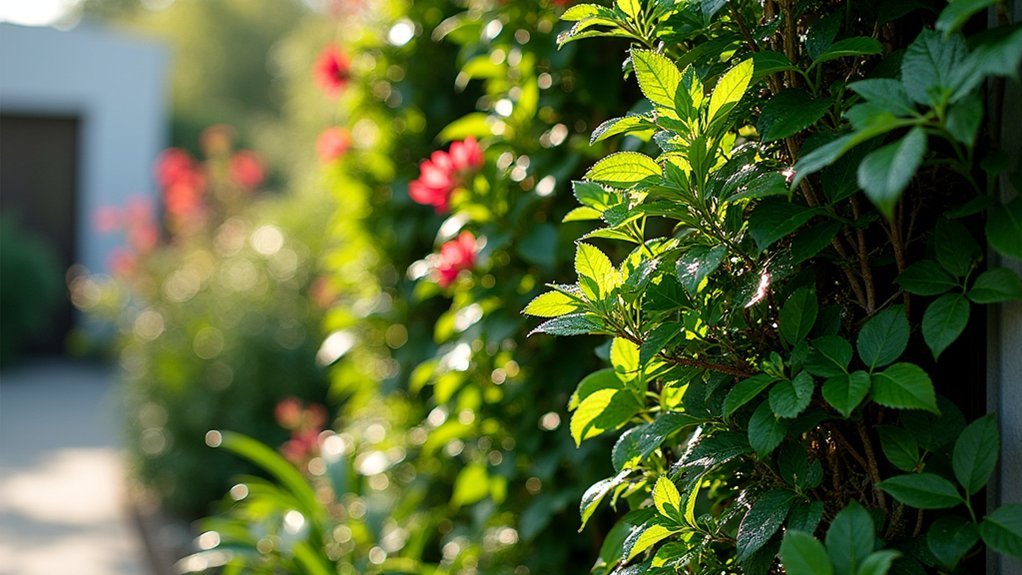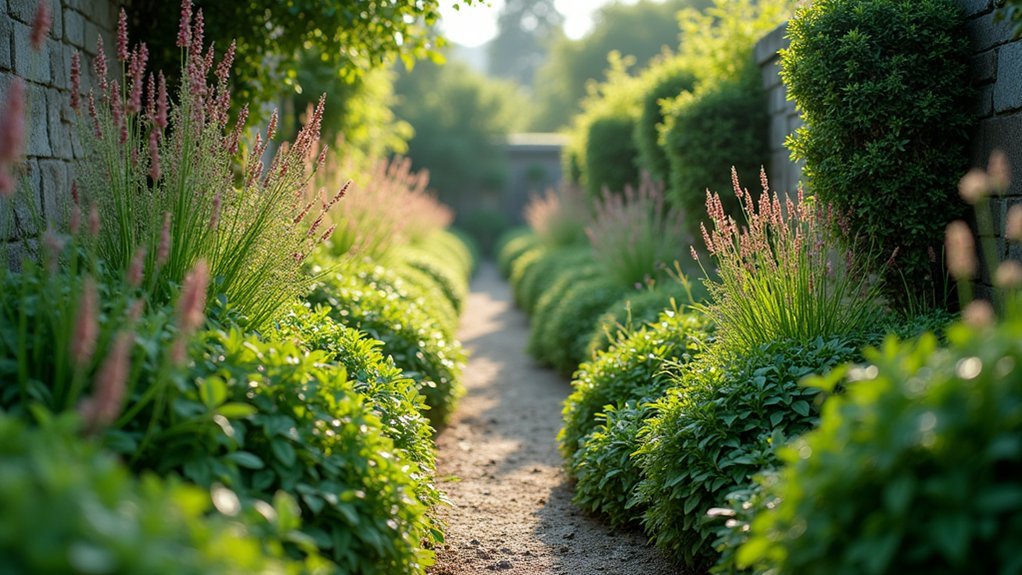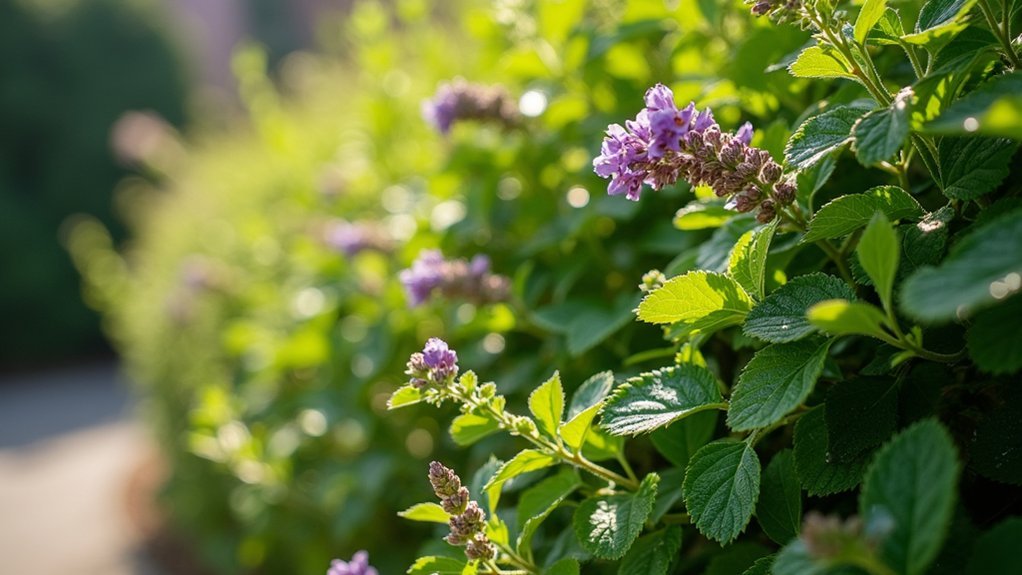Native hedge plants that excel in slim spaces include columnar junipers, highbush blueberries, and dwarf varieties like witch-alder and pink meadowsweet. You’ll maximize privacy while using minimal horizontal space by planting these native shrubs in a zig-zag pattern about 30 cm apart. Their vertical growth creates effective 3-10 foot screening while supporting local wildlife and requiring less maintenance than non-natives. The right slim-profile hedge can transform your limited space into a biodiverse sanctuary.
Benefits of Vertical Native Hedges in Limited Spaces

When space comes at a premium in your garden or landscape, vertical native hedges offer an elegant solution that maximizes every inch of available ground.
By utilizing upward growth patterns, these hedges create privacy and density without sacrificing your limited horizontal space.
Native vertical hedges rise skyward, offering essential privacy while preserving your garden’s precious footprint.
You’ll find that dwarf varieties of native shrubs, like dwarf witch-alder and pink meadowsweet, can provide effective 3-4 foot screening while fitting perfectly in narrow areas.
Beyond their space-saving benefits, these vertical green barriers improve your outdoor comfort by reducing noise and blocking wind.
Your modest green space will also contribute to improved air quality and reduced urban heat.
Plus, you’re supporting local wildlife—these native plantings create valuable habitat for pollinators and birds, enhancing biodiversity right in your own backyard.
Top Columnar Native Shrubs for Property Boundaries
You’ll find columnar native shrubs offer perfect skinny privacy solutions when space is tight along property lines.
These vertical growth champions can reach impressive heights of 5-10 feet while maintaining a slim profile of just 30-40 cm in width.
Native options like columnar junipers and highbush blueberries not only create effective boundaries but also support local wildlife while requiring minimal maintenance once established.
Skinny Privacy Solutions
Space-challenged homeowners need not sacrifice privacy due to limited yard width. Columnar native hedge options like junipers and highbush blueberries offer excellent screening while maintaining a slim profile.
These vertical growers typically reach 5-6 feet tall, providing effective property boundaries without consuming precious horizontal space. For maximum density, plant them in a zig-zag double row with just 30 cm between each shrub.
You’ll appreciate highbush blueberries for their dual purpose—privacy screening plus edible fruit production. That’s practical landscaping at its finest!
Regular pruning helps maintain your slim hedge’s shape and promotes healthy growth.
With these space-efficient native options, you’ll create an effective privacy screen that fits perfectly in narrow areas while keeping your landscape looking naturally beautiful.
Vertical Growth Champions
Five outstanding native shrubs stand tall as champions for narrow property lines where horizontal space comes at a premium. Columnar junipers lead the pack with their slim, upright habit—perfect for tight boundaries without sacrificing your yard’s usable area.
Highbush blueberries offer a softer silhouette while doubling as edible landscape elements. Their vertical growth champions your need for both beauty and function.
American cranberry, reaching 3-4 feet in height, thrives in sunny spots and provides wildlife support while maintaining a compact footprint.
For textural interest, incorporate arrowwood (Viburnum dentatum), which grows upright while attracting essential pollinators.
When planting these vertical growth champions, space them approximately 30 cm apart to guarantee proper air circulation and light penetration—crucial factors for developing healthy, dense privacy screens in narrow spaces.
Designing Your Slim-Profile Native Hedge

Many homeowners face the challenge of creating verdant boundaries in limited spaces. When planning your slim-profile hedge, consider columnar junipers for their impressive density without lateral sprawl.
These native plants provide excellent screening while respecting spatial constraints.
For small areas, incorporate dwarf varieties like Fothergilla gardenia and Spirea tomentosa, which max out at just 3-4 feet tall and thrive in sunny locations.
Where shade is prevalent, leatherwood offers a tidy alternative that won’t struggle in less sunny spots.
Maximize density by arranging plants in a zig-zag pattern, keeping them 30 cm apart for ideal development.
Create biodiversity by mixing varieties like highbush blueberries and American cranberry—these native options support local ecosystems while maintaining manageable proportions for your slim hedge design.
Soil Preparation and Planting Techniques for Narrow Areas
While establishing native hedges in limited spaces presents unique challenges, proper soil preparation remains the foundation for success.
Native hedge success in tight spaces starts with quality soil preparation—the essential groundwork for thriving results.
You’ll need to loosen the soil to at least 12 inches deep, ensuring your native shrubs develop strong root systems despite spatial constraints. Incorporating organic matter like compost greatly improves fertility and moisture retention—critical factors in narrow planting zones.
For ideal results when planting:
- Position each plant approximately 30 cm apart, creating sufficient space for air circulation while maintaining visual density
- Consider a zig-zag double row arrangement to maximize coverage without overcrowding
- Thoroughly water newly planted hedges, especially during establishment and dry periods
- Monitor soil moisture regularly, as narrow spaces can sometimes dry out more quickly than open garden beds
Seasonal Maintenance for Compact Native Hedgerows

Because compact native hedgerows grow in limited spaces, they require attentive seasonal care to thrive fully.
Regular pruning during the first few years encourages bushy growth and controls size—critical for maintaining these space-efficient barriers.
Don’t overlook weeding around your native shrubs, especially when newly planted.
Apply mulch to suppress weeds and conserve moisture during dry periods.
Water thoroughly after installation and during droughts to establish strong root systems.
A balanced fertilizer application in early spring will promote healthy growth and abundant flowering, maximizing the ecological benefits of your compact hedge.
Adjust your maintenance routine with the seasons, observing local conditions closely.
This responsive approach guarantees your native shrubs maintain their intended density and appearance, even in the narrowest garden spaces.
Wildlife Support From Space-Efficient Native Plantings
You’ll be amazed how even the slimmest native hedgerows can create biodiversity hotspots that rival larger habitats, supporting everything from nesting songbirds to essential pollinators.
These space-efficient plantings establish crucial migration corridors that help wildlife navigate fragmented landscapes, connecting isolated populations despite minimal width requirements.
Slim Hedges Maximize Biodiversity
Even in the smallest gardens or narrowest borders, native slim hedges can create thriving wildlife havens that punch well above their weight ecologically.
You’ll need just 6 feet of width to establish layered vegetation that naturally suppresses weeds while supporting countless native insects.
Choose compact native shrubs like dwarf witch-alder, pink meadowsweet, and lowbush blueberry that mature at 3-4 feet tall.
Mixing species such as hazelnut, leatherwood, and arrowwood creates diverse habitat corridors while deterring unwanted wildlife.
- Vibrant meadowsweet blossoms attracting butterflies and native bees
- Songbirds darting in and out of dense arrowwood foliage with berries
- Small mammals finding shelter beneath the intertwined branches
- Blueberry shrubs offering both human harvest and wildlife sustenance
Your slim hedge isn’t just space-efficient—it’s an ecological powerhouse connecting fragmented habitats.
Nesting Opportunities Without Width
Native hedges excel beyond their ecological footprint by offering robust nesting habitats without demanding excessive space. You’ll find that strategic planting of dense native shrubs creates protective environments where birds and small mammals can safely raise their young.
| Plant Type | Nesting Benefit | Height | Conditions |
|---|---|---|---|
| Nootka Rose | Thorny protection | 6-8 ft | Sun/part shade |
| Snowberry | Dense understory | 3-5 ft | Adaptable |
| Red-flowering Currant | Early foliage | 6-9 ft | Part shade |
| Black Twinberry | Spreading cover | 5-10 ft | Moist soil |
Compact Corridors For Migration
You don’t need vast acreage to support wildlife migration. Even slim spaces can become crucial ecological connections when planted with diverse native shrubs. A minimum width of 6 feet (15 feet ideally) creates effective wildlife corridors that link fragmented habitats.
By incorporating at least twelve species in your compact hedgerow, you’ll build ecosystem resiliency while discouraging opportunistic weeds through layered planting.
- Dwarf witch-alder and pink meadowsweet forming dense understory layers where small creatures can safely travel
- Shade-tolerant native shrubs creating green tunnels beneath tree canopies
- Drought-resistant varieties establishing migration routes across challenging terrain
- Multi-season flowering natives offering continuous food sources for pollinators moving through the landscape
These strategic plantings turn narrow spaces into biodiversity highways, allowing plants and animals to move freely between habitats despite limited room.
Creating Privacy With Minimal Footprint: Success Stories
When space is limited in your yard, selecting the right native shrubs for privacy hedges becomes essential for success.
You’ll find dwarf witch-alder and pink meadowsweet particularly effective, as they grow just 3-4 feet tall while tolerating drought once established.
For shady areas, leatherwood offers a tidy solution that fits perfectly in narrow spaces.
If you’re looking to combine privacy with edible benefits, consider highbush blueberries as a soft hedge option.
Need quick coverage? Nootka roses and snowberries spread via root shoots, creating dense screens without demanding excessive width.
Fast-growing natives like Nootka roses and snowberries create natural privacy screens through underground expansion, perfect for narrow garden spaces.
For visual diversity in tight spaces, try planting a combination of Osoberries, red-flowering currants, and black twinberries.
These native plant combinations have proven successful for homeowners working with minimal footprints while achieving maximum privacy.
Frequently Asked Questions
What Is the Best Plant for a Narrow Privacy Hedge?
For a narrow privacy hedge, you’ll find columnar junipers ideal as they grow tall with a slim profile. You can also consider highbush blueberries if you’d like an edible option that provides dense coverage.
What Is the Quickest Growing Native Hedge?
You’ll find Nootka roses grow exceptionally fast, reaching maturity in just a few years. Snowberries, Osoberry, and red-flowering currant also establish quickly. Combine these natives for the fastest-growing natural hedge possible.
What Is the Best Plant to Block Neighbors’ Views?
You’ll find Nootka roses ideal for blocking neighbors’ views. They’re quick-growing, spread through root shoots, and stay under 10 feet tall. Columnar junipers offer dense privacy in slim spaces too.
How to Create a Native Hedgerow?
Plant native shrubs in a zigzag pattern 30cm apart using at least 2-3 diverse species. You’ll want fast-growing varieties like Nootka roses and snowberries. Plant in fall or winter and maintain regular pruning for density.
In Summary
You’ve discovered how native hedge plants can transform even the slimmest spaces into vibrant, functional boundaries. By selecting columnar species, preparing soil properly, and maintaining your hedge seasonally, you’ll enjoy privacy without sacrificing square footage. Your narrow native hedge isn’t just space-efficient—it’s creating essential wildlife habitat while defining your property beautifully. Start small, think vertical, and watch your slim-profile hedge become a standout feature of your landscape.





Leave a Reply